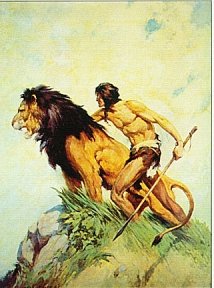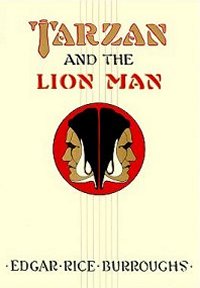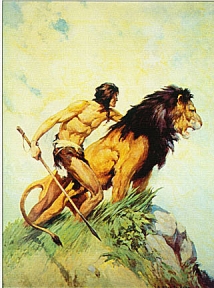Introduction
As has been seen 1931 was a very
eventful year for ERB. The viewing of Trader Horn was a seminal
event in his life. The movie became a major influence on his next
novel
Tarzan And The Leopard Men. As has been noted, in April
he signed the contract with MGM.
Reports vary but it appears that
he may have sold the movie rights for the first film for twenty-two thousand
dollars plus a five week employment contract at a thousand a week.
It is fair to assume that ERB spent this five weeks on the MGM lot in Culver
City.
During that period of time he
obviously attended conferences with Irving Thalberg so his descriptions
of the 'Boy Wonder' are taken first hand. One imagines that he became
acquainted with the Director Woody 'One Take' Van Dyke. I like to
think they hit if off with ERB getting some first hand accounts of Africa
that showed up in Leopard
Men and Lion
Man. As he had a copy of Van Dyke's privately printed Horning
Into Africa in his library it would seem obvious that Van Dyke
presented him with a copy. Thus ERB had a fund of first hand information
lacking in his earlier novels.
One also imagines he met the
Africans Mutia and Riano. They would have been the first Africans
he had met. There is a world of difference between Africans and American
Negroes. Perhaps for these reasons his Leopard Men varies
somewhat from his usual hidden civilizations formula.
And also he would have met his
script writing counterpart Cyril Hume. His new partner one might
say.
And coincidentally, Johnny Weissmuller
and Maureen O'Sullivan.
One is astonished at the speed
with which MGM signed Burroughs, developed a script, found actors for Tarzan
and Jane, made the movie and released it a bare ten months later.
Good work!
We know that ERB watched the
result with a sinking heart and bitter remorse for signing the contract.
The MGM version of his creation was the antithesis of his own. Rather
than a literate, actually cosmopolitan Tarzan at home both in the jungle
and the capitols of Europe and cities of America the MGM Tarzan was a feral
boy who wasn't even a lord, never even the lord of the jungle.
Our man had just finished Tarzan
And The City Of Gold when he viewed the movie. Now with his
brain reeling in shock it would be a year before he got out his reply.
In my estimation it would be
his last great Tarzan novel. The Big Bwana had been emasculated.
But the greatest of the Tarzan novels was the result.
ERB also made it a Hollywood
novel, perhaps as trenchant a criticism as his 1922 effort The
Girl From Hollywood. He ridiculed the whole thing.
MGM, Thalberg, the African expedition, the movie Tarzan and in a closing
chapter Hollywood itself. In his pain and hurt he drove himself to
heights he had never before attained.
Stunned by the duplicity of MGM
his novel is a story of duplicity, of doubles and more doubles until one
has doubles coming out one's ears. The story within the story, the
double of the story itself, of God in Heaven but all wrong with the world
is a masterpiece of imaginative fiction that transcends even the
exploits of Ras Thavas.
As Leopard Men was permeated
by sexual desire with a hint of madness, Lion Man is deeply involved
with madness, insanity and a complete feeling of unreality. As Tarzan
says: Sometimes I think I must be dreaming. Yea, verily, Brothers
and Sisters. This story is one of dreams and nightmares but a dream
of a story.
1.
In the novel Burroughs had two major objectives:
1. To ridicule and humiliate MGM and 2. To show them how to use all new
material in a much more imaginative way than Cyril Hume had. Hume
is probably ridiculed as the scenarist Pluant in the Hollywood afterword.
There can be no mistake that
the introductory story refers to the Trader Horn expedition while Burroughs
includes a planning session with Milt Smith/ Irving Thalberg in his MGM/BO
office. Let us look at the introductory chapter carefully.
There can be no doubt that Burroughs
was included in such sessions concerning Tarzan, The Ape Man so
that the chapter 'In Conference' is an authentic snapshot of how business
was conducted.
The opening sentence is:
Mr. Milton Smith, Executive Vice President in Charge of Production, was
in conference. There is no doubt Burroughs is referring to Irving
Thalberg. Burroughs goes on to describe Thalberg's actions which
were considered peculiar by everyone in Hollywood.
Mr. Smith had a chair behind a big desk, but he seldom occupied it.
He was an imaginative dynamic person. He required freedom and space
in which to express himself. His large chair was too small; so he
paced about his office more often than he occupied the chair, and his hands
interpreted his thoughts quite as fluently as his tongue.
p.9.
Smith was walking around the room, acting out the scene. He was the
girl bathing in the pool in one corner of the room, and then he went to
the opposite corner and was the Lion Man.
That doesn't sound unfriendly or
hostile to me but as ERB has already identified MGM as BO (Body Odor) pictures
the people at MGM may have taken all ERB's comments from then on as intended
insults.
In point of fact ERB's descriptions
of Smith/Thalberg seems to be accurate. Thalberg was the subject
of Scott Fitzgerald's unfinished final book The Last Tycoon.
The novel was made into a movie of the same name in 1976, the last movie
directed by Elia Kazan. Thalberg is portrayed exactly as Burroughs
depicted him.
The conventional mind seems to
be unable to grasp the idiosyncracies of genius. The genius
of Thalberg was that he was able to visualize the film in the manner Burroughs
describes, almost as an author. Had he failed he would have been
merely weird but as he was the greatest and surest producer of the studio
era the seeming eccentricity becomes an attribute of his genius.
As a writer of genus I think ERB saw Thalberg that way; how the latter
or MGM interpreted ERB's remarks may have been less generous.
The director, Tom Orman's character,
is quite simlar to that of Woody Van Dyke although as the physique of Orman
is apposite that of Van Dyke it is clear that Orman is intended to be more
fictional. The name Or-man can be interpreted as Gold-man from the
French Or which translates as gold. As Goldman ERB may have been
slamming the Jews. ERB was less than careful in that respect in the
novel. In the last chapter ERB definitely characterizes Abe Potkin
as a Jew placing his conversation in dialect. By Abe Potkin ERB may
have been referring to Louis B. Mayer. The introduction of Clayton
to Abe leaves this open to conjecture. P. 186:
This is Mr. Potkin, John Clayton, Abe Potkin, you know, (italics
mine)
If ERB did ridicule both Thalberg
and Mayer or was perceived as doing so then he was definitely asking for
trouble. Fighting the law in Hollywood as it were.
Like Van Dyke who had been called in
to relieve director Robert J. Flaherty on a behind schedule film White
Shadows On The South Seas in which Van Dyke was successful so Orman
had been called in to complete a picture being shot in Borneo.
Just as Van Dyke was then assigned
Trader Horn on location in Africa so now Orman is assigned to make
the biggest African picture ever in the Ituri Rain Forest.
ERB probably met Van Dyke in
the summer of '31 on the MGM lot. It would seem that the two men
hit it off as Orman is as well treated as Lion Man allows.
It is to be presumed that Van Dyke presented ERB with a copy of his privately
printed Horning Into Africa at that time.
The rest of the chapter is joshing
around in light hearted banter that was probably characteristic of this
type of conference and introducing the members of the cast thus establishing
the nature of their characters.
A detail of interest is the following
quote. P. 8:
"And are we going to shoot:" inquired Orman, "fifty miles from Hollywood?"
"No, sir!
We're goin' to send a company right to the heart of Africa, right to the-
er-ah- what's the name of that forest, Joe?"
"The Ituri
Forest."
"Yes,
right to the Ituri Forest with sound equipment and everything. Think
of it, Tom! You get the real stuff, the real natives, the jungle,
the animals, the sounds. You 'shoot' a giraffe, and at the same time
you record the actual sound of his voice."
"You won't
need much sound equipment for that, Milt."
"Why?"
"Giraffes
don't make any sounds; they're not supposed to have any vocal organs."
"Well,
what of it? That was just an illustration. But take the other
animals for instance; lions, elephants, tigers- Joe's written a great tiger
sequence. It's going to yank them right out of their seats."
"There
ain't any tigers in Africa, Milt," explained the director.
"Who say
there ain't?"
"I do,"
replied Orman, grinning.
'How about
it, Joe?" Smith turned toward the scenarist.
"Well,
Chief, you said you wanted a tiger sequence."
"Oh, what's
the difference? We'll make it a crocodile sequence."
In this instance ERB is spoofing
himself. Over the years he had all kinds of complaints for faunal
inaccuracies. The tiger bit probably hurt him the worst. He
had written a great tiger scene for the first Tarzan novel that had to
be changed from the All Story version to the book version. ERB finally
gets a chance to exorcise his frustration over that one. He was also
criticized for having deer in Africa, Bara the deer, of which their are
none. He first tried to bull his way through by saying he just wanted
Bara the deer there. He gave in by Invincible and spoke of
Bara the antelope. This also apparently proved unacceptable as in
Leopard Men he speaks of Wappi the antelope, while the name Bara
disappears completely.
In the joke about the giraffe voice
he is showing off knowledge while venting a little steam.
Thus he sets the scene for the
first stage of the novel, the penetration of the film company into the
Ituri Rain Forest. I found this sequence as well handled as any movie
version might have been. ERB doesn't try to follow Van Dyke's narrative
but creates his own story based on Van Dyke's.
I have no doubt that there are
references in this introduction and throughout the book to real people
and real incidents that have gone over my head. I have located what
I can with my present knowledge but I'm sure the novel is loaded with many
others.




